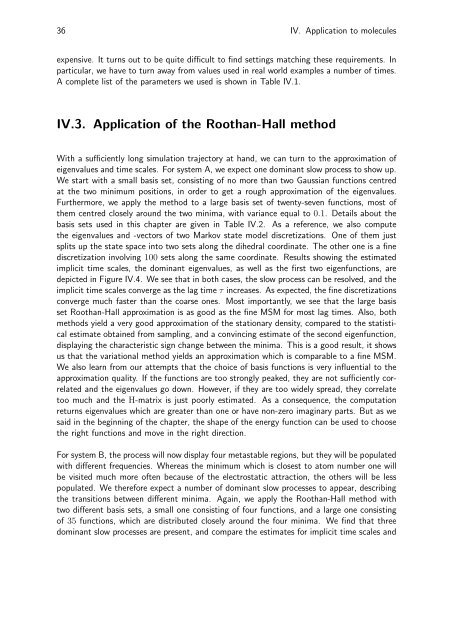Variational Principles in Conformation Dynamics - FU Berlin, FB MI
Variational Principles in Conformation Dynamics - FU Berlin, FB MI
Variational Principles in Conformation Dynamics - FU Berlin, FB MI
- No tags were found...
Create successful ePaper yourself
Turn your PDF publications into a flip-book with our unique Google optimized e-Paper software.
36 IV. Application to moleculesexpensive. It turns out to be quite difficult to f<strong>in</strong>d sett<strong>in</strong>gs match<strong>in</strong>g these requirements. Inparticular, we have to turn away from values used <strong>in</strong> real world examples a number of times.Acompletelistoftheparametersweusedisshown<strong>in</strong>Table IV.1.IV.3. Application of the Roothan-Hall methodWith a sufficiently long simulation trajectory at hand, we can turn to the approximation ofeigenvalues and time scales. For system A, we expect one dom<strong>in</strong>ant slow process to show up.We start with a small basis set, consist<strong>in</strong>g of no more than two Gaussian functions centredat the two m<strong>in</strong>imum positions, <strong>in</strong> order to get a rough approximation of the eigenvalues.Furthermore, we apply the method to a large basis set of twenty-seven functions, most ofthem centred closely around the two m<strong>in</strong>ima, with variance equal to 0.1. Detailsaboutthebasis sets used <strong>in</strong> this chapter are given <strong>in</strong> Table IV.2. As a reference, we also computethe eigenvalues and -vectors of two Markov state model discretizations. One of them justsplits up the state space <strong>in</strong>to two sets along the dihedral coord<strong>in</strong>ate. The other one is a f<strong>in</strong>ediscretization <strong>in</strong>volv<strong>in</strong>g 100 sets along the same coord<strong>in</strong>ate. Results show<strong>in</strong>g the estimatedimplicit time scales, the dom<strong>in</strong>ant eigenvalues, as well as the first two eigenfunctions, aredepicted <strong>in</strong> Figure IV.4. Weseethat<strong>in</strong>bothcases,theslowprocesscanberesolved,andtheimplicit time scales converge as the lag time τ <strong>in</strong>creases. As expected, the f<strong>in</strong>e discretizationsconverge much faster than the coarse ones. Most importantly, we see that the large basisset Roothan-Hall approximation is as good as the f<strong>in</strong>e MSM for most lag times. Also, bothmethods yield a very good approximation of the stationary density, compared to the statisticalestimate obta<strong>in</strong>ed from sampl<strong>in</strong>g, and a conv<strong>in</strong>c<strong>in</strong>g estimate of the second eigenfunction,display<strong>in</strong>g the characteristic sign change between the m<strong>in</strong>ima. This is a good result, it showsus that the variational method yields an approximation which is comparable to a f<strong>in</strong>e MSM.We also learn from our attempts that the choice of basis functions is very <strong>in</strong>fluential to theapproximation quality. If the functions are too strongly peaked, they are not sufficiently correlatedand the eigenvalues go down. However, if they are too widely spread, they correlatetoo much and the H-matrix is just poorly estimated. As a consequence, the computationreturns eigenvalues which are greater than one or have non-zero imag<strong>in</strong>ary parts. But as wesaid <strong>in</strong> the beg<strong>in</strong>n<strong>in</strong>g of the chapter, the shape of the energy function can be used to choosethe right functions and move <strong>in</strong> the right direction.For system B, the process will now display four metastable regions, but they will be populatedwith different frequencies. Whereas the m<strong>in</strong>imum which is closest to atom number one willbe visited much more often because of the electrostatic attraction, the others will be lesspopulated. We therefore expect a number of dom<strong>in</strong>ant slow processes to appear, describ<strong>in</strong>gthe transitions between different m<strong>in</strong>ima. Aga<strong>in</strong>, we apply the Roothan-Hall method withtwo different basis sets, a small one consist<strong>in</strong>g of four functions, and a large one consist<strong>in</strong>gof 35 functions, which are distributed closely around the four m<strong>in</strong>ima. We f<strong>in</strong>d that threedom<strong>in</strong>ant slow processes are present, and compare the estimates for implicit time scales and









